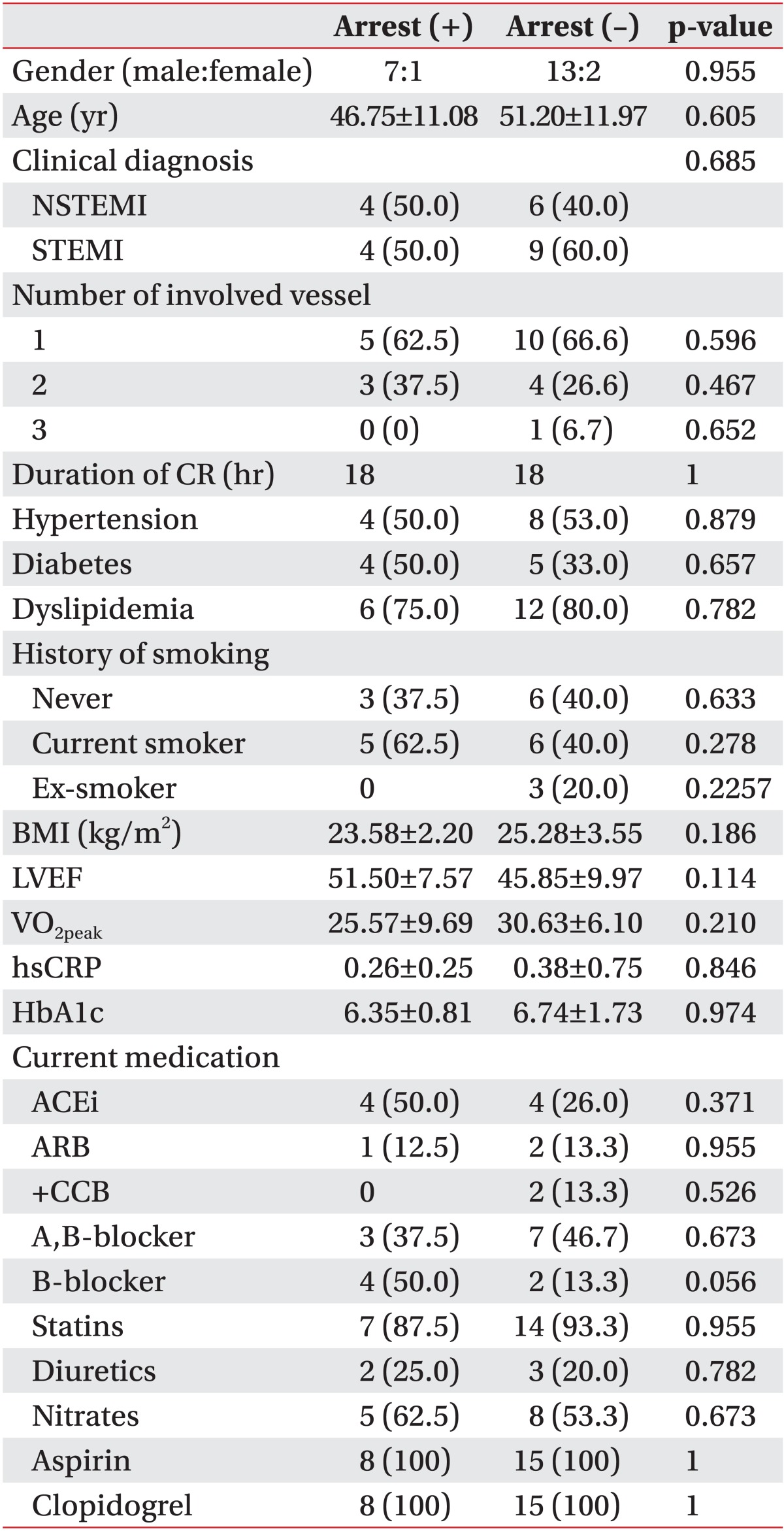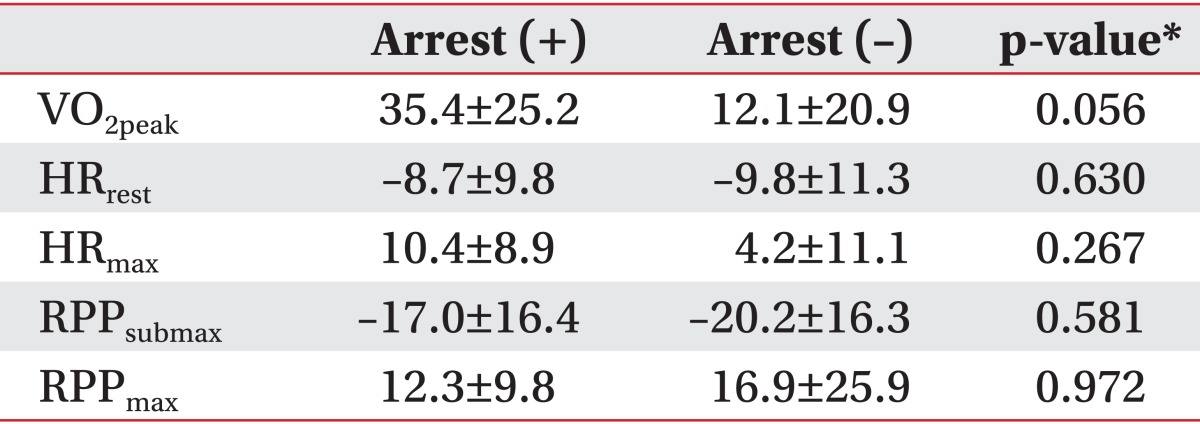1. Jacobs I, Nadkarni V, Bahr J, Berg RA, Billi JE, Bossaert L, et al. Cardiac arrest and cardiopulmonary resuscitation outcome reports: update and simplification of the Utstein templates for resuscitation registries: a statement for healthcare professionals from a task force of the International Liaison Committee on Resuscitation (American Heart Association, European Resuscitation Council, Australian Resuscitation Council, New Zealand Resuscitation Council, Heart and Stroke Foundation of Canada, InterAmerican Heart Foundation, Resuscitation Councils of Southern Africa). Circulation 2004;110:3385-3397. PMID:
15557386.


2. Zipes DP, Wellens HJ. Sudden cardiac death. Circulation 1998;98:2334-2351. PMID:
9826323.


3. Wit AL, Janse MJ. Experimental models of ventricular tachycardia and fibrillation caused by ischemia and infarction. Circulation 1992;85(1 Suppl): I32-I42. PMID:
1728503.

4. Nadkarni VM, Larkin GL, Peberdy MA, Carey SM, Kaye W, Mancini ME, et al. First documented rhythm and clinical outcome from in-hospital cardiac arrest among children and adults. JAMA 2006;295:50-57. PMID:
16391216.


5. Eisenberg MS, Mengert TJ. Cardiac resuscitation. N Engl J Med 2001;344:1304-1313. PMID:
11320390.


6. Bunch TJ, White RD, Gersh BJ, Meverden RA, Hodge DO, Ballman KV, et al. Long-term outcomes of out-of-hospital cardiac arrest after successful early defibrillation. N Engl J Med 2003;348:2626-2633. PMID:
12826637.


7. Cobbe SM, Dalziel K, Ford I, Marsden AK. Survival of 1476 patients initially resuscitated from out of hospital cardiac arrest. BMJ 1996;312:1633-1637. PMID:
8664715.



8. Dugmore LD, Tipson RJ, Phillips MH, Flint EJ, Stentiford NH, Bone MF, et al. Changes in cardiorespiratory fitness, psychological wellbeing, quality of life, and vocational status following a 12 month cardiac exercise rehabilitation programme. Heart 1999;81:359-366. PMID:
10092561.



9. Taylor RS, Brown A, Ebrahim S, Jolliffe J, Noorani H, Rees K, et al. Exercise-based rehabilitation for patients with coronary heart disease: systematic review and meta-analysis of randomized controlled trials. Am J Med 2004;116:682-692. PMID:
15121495.


10. O'Connor GT, Buring JE, Yusuf S, Goldhaber SZ, Olmstead EM, Paffenbarger RS Jr, et al. An overview of randomized trials of rehabilitation with exercise after myocardial infarction. Circulation 1989;80:234-244. PMID:
2665973.


11. Witt BJ, Jacobsen SJ, Weston SA, Killian JM, Meverden RA, Allison TG, et al. Cardiac rehabilitation after myocardial infarction in the community. J Am Coll Cardiol 2004;44:988-996. PMID:
15337208.


12. American Association of Cardiovascular and Pulmonary Rehabilitation. Guidelines for cardiac rehabilitation and secondary prevention programs. 4th ed. Champaign: Human Kinetics; 2004.
13. Paul-Labrador M, Vongvanich P, Merz CN. Risk stratification for exercise training in cardiac patients: do the proposed guidelines work? J Cardiopulm Rehabil 1999;19:118-125. PMID:
10200918.


14. Law MR, Watt HC, Wald NJ. The underlying risk of death after myocardial infarction in the absence of treatment. Arch Intern Med 2002;162:2405-2410. PMID:
12437397.


15. The World Health Report 1997: conquering suffering, enriching humanity. World Health Forum 1997;18:248-260. PMID:
9478137.


16. Balady GJ, Ades PA, Comoss P, Limacher M, Pina IL, Southard D, et al. Core components of cardiac rehabilitation/secondary prevention programs: a statement for healthcare professionals from the American Heart Association and the American Association of Cardiovascular and Pulmonary Rehabilitation Writing Group. Circulation 2000;102:1069-1073. PMID:
10961975.


17. Jolliffe JA, Rees K, Taylor RS, Thompson D, Oldridge N, Ebrahim S. Exercise-based rehabilitation for coronary heart disease. Cochrane Database Syst Rev 2001;(1): CD001800PMID:
11279730.


18. Vanhees L, Stevens A, Schepers D, Defoor J, Rademakers F, Fagard R. Determinants of the effects of physical training and of the complications requiring resuscitation during exercise in patients with cardiovascular disease. Eur J Cardiovasc Prev Rehabil 2004;11:304-312. PMID:
15292764.


19. Thomas RJ, Miller NH, Lamendola C, Berra K, Hedback B, Durstine JL, et al. National Survey on Gender Differences in Cardiac Rehabilitation Programs: patient characteristics and enrollment patterns. J Cardiopulm Rehabil 1996;16:402-412. PMID:
8985799.











